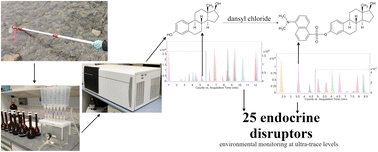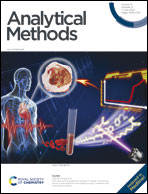A robust multi-residue method for the monitoring of 25 endocrine disruptors at ultra-trace levels in surface waters by SPE-LC-MS/MS†
Abstract
Estrogenic endocrine disruptors are one of the biggest ecotoxicological threats in water that pose a significant ecological burden and health-risk for humans due to their high biological activity and proven additive effects. Therefore, we have developed and validated the most comprehensive and ultra-sensitive analytical method published to date, for reliable quantification of 25 high-risk endocrine disruptors at their ecologically relevant concentrations: naturally excreted hormones (estradiol, estrone, estriol, testosterone, corticosterone, and progesterone), synthetic hormones used for contraception and menopausal symptoms (ethinylestradiol, drospirenone, chlormadinone acetate, norgestrel, gestodene, tibolone, norethindrone, dienogest, and cyproterone) and bisphenols (BPS, BPA, BPF, BPE, BPAF, BPB, BPC, and BPZ). It is based on a solid-phase extraction of water samples, followed by a robust dansyl chloride derivatization with detection by liquid chromatography-tandem mass spectrometry with a single sample preparation and two analytical methods using the same analytical column and mobile phases. The achieved limits of quantitation are in the sub-ng L−1 range, and detection limits as low as 0.02 ng L−1, meeting the newest proposal for environmental quality standards (EQS) by the EU water framework directive for estradiol and ethinylestradiol. The method was extensively validated and applied to seven representative Slovenian water samples, where we detected 21 out of 25 analytes; 13 were quantified in at least one sample. Estrone and progesterone were quantified in all samples, reaching levels up to 50 ng L−1; ethinylestradiol was higher than the current EQS (0.035 ng L−1) in three samples, and estradiol was above its EQS (0.4 ng L−1) in one sample, proving the method's applicability and the necessity for monitoring these pollutants.



 Please wait while we load your content...
Please wait while we load your content...